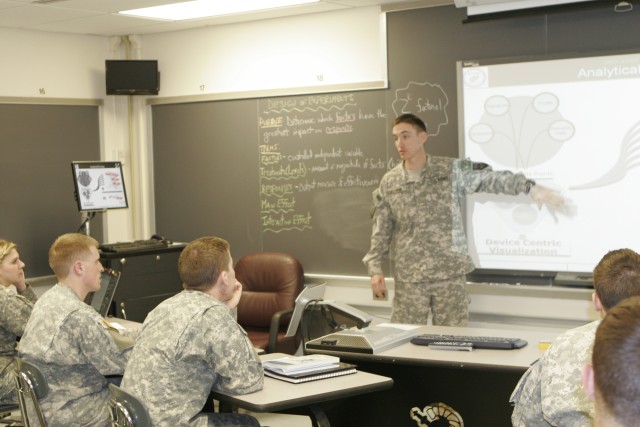West Point cadets and officers are bringing social networking out of the classroom and into the fight by improving how intelligence analysts process vital data on insurgents in Iraq and Afghanistan.
Maj. Ian McCulloh, an assistant professor in the Department of Behavioral Sciences and Leadership, has streamlined counterinsurgency methods by using the Organizational Risk Analyzer program to determine what persons in a terrorist network hold the most valuable information.
The program was developed by Kathleen Carley, Ph.D, a computer science professor and director of the Center for Computational Analysis of Social and Organizational Systems at Carnegie Mellon.
McCulloh first used ORA while working on his doctoral dissertation there and contributed to further development of the software. After completing graduate school, he decided that ORA was a valuable and user-friendly program to process meta-network data and started adapting it to use for counterterrorism.
Meta-networking, McCulloh said, is the study of how people, knowledge, resources and tasks relate to each other. He reasoned that much of the intelligence gathered on terrorists in Iraq and Afghanistan is meta-network data.
To prove ORA's processing utility, McCulloh went to Afghanistan to meet with an intelligence analyst, review the analyst's data and use a program he wrote to translate the analyst's notes and process it through ORA.
"Once we could do that, I could do what would take a traditional analyst a week to do in a couple of hours," McCulloh said. "That impressed them, and it was actually able to be a more objective analysis of the data they were looking at."
Though his work didn't find any new insights, McCulloh proved the work could be done much faster. This led to interest in teaching analysts how to use social network analysis, so he put together a modified version of PL470 to teach analysts in Afghanistan and deploying mobile training teams.
Maj. Ed Teague, the chief operations systems research analyst for Combined Joint Task Force Paladin in Afghanistan and a Class of 1995 graduate, is a beneficiary of that class.
He is currently assigned to the Joint IED Defeat Organization, where he uses ORA to track down chief IED makers and key connections in the terrorist network.
"If I do my math right, I can point to one guy and get just as much information (from) one guy as I can from 50 random guys," Teague said.
Teague was a Dept. of Systems Engineering instructor from 2006 to 2009. The department invited him to come to West Point March 11 to teach cadets about social networking and counterinsurgency.
"It (social networking) allows us to look at a network of personnel that are related through action, resources (and) knowledge as links between different organizations," Teague said, "and it lets me figure out who I should focus on in order to disrupt or get more information about those particular networks."
By using ORA to quickly pinpoint key targets, social networking reduces the risk in the patrolling Soldier's job in three ways, Teague said. First, it prevents the Soldier from pursuing the wrong targets.
Next, that Soldier can pick up the people with the most information using improved intelligence briefs.
Finally, if that Soldier helps to successfully unhinge the network, then that network's strength dissipates.
McCulloh and Maj. Tony Johnson, a mathematics professor, are both promoting ORA's utility. Johnson has been in Afghanistan since last August working with analysts using ORA.
McCulloh has a reachback cell in Thayer Hall set up with SIPR computers where a team of cadets receive data from theater to process through ORA and make target recommendations.
Johnson's son, Yearling Benjamin Allen Johnson, from Richmond, Va., is a member of that team which serves as a "piece of the puzzle" in bringing together data from the field in an objective manner to see who in a terrorist organization is most important.
"From the information analysis standpoint, that's a really big thing, especially that we can do it so fast and have it back out to them," Johnson said. "If it takes a week to analyze it, then that's a week lost already which could have been used to find the (targets)."
Once the software is approved for use theater-wide, Teague expects it will become an important part of the day-to-day operations of analysts focused on counterinsurgency.


Social Sharing